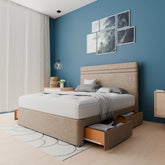Do you know the Different Types of Mattress? As you are aware, purchasing a mattress may be incredibly stressful. Because it is a significant investment and one of the household objects with the greatest influence on the quality of your daily and overnight life. Especially with so many different types of mattresses available. Trying to narrow down your selections based on comfort, quality, and affordability might be difficult.
Fortunately, this does not have to be the case. This article is intended to simplify the process and make purchasing a mattress as easy as possible. As well as the sleep you'll get as soon as you bring it home.
What Are the Best Several Kinds of Mattresses?
However, if you are not familiar with the different types of mattresses that are available in stores and online. And it should assist you in narrowing down your options in order to locate the ideal type of bed for you.
Memory Foam
Memory foam is popular because it distributes your body weight well, reducing pressure points. It's an excellent solution for folks who suffer from joint or bodily ache. These beds are available in a variety of hardness levels, making it simple to pick the perfect memory foam bed for you.
Traditional memory foam is made from petroleum, and one of the most prevalent complaints about memory foam is that it traps heat and off-gases. Memory foam warms up because it was meant to soften when exposed to heat, and its dense structure is also prone to trapping body heat.
PROS |
CONS |
|
Gives great pain and pressure point alleviation. |
Traditional memory foam has the potential to trap body heat. |
|
Motion transmission is absorbed. |
Inadequate response time. |
|
Allergen and dust mite resistance. |
Sleepers who are too soft may feel confined. |
Also Read: Pros And Cons Of Soft And Firm Mattresses - A Guide
Hybrid Mattress
Hybrid mattresses have contained coils and at least a three-inch layer of comfort foam. The most prevalent are latex and memory foam hybrids. The coil layer promotes airflow throughout the mattress, while the cushioned comfort layers relieve pressure spots.
Rather than a cotton or wool pillow top, a comfort layer made of foam has less motion transmission and provides better pain relief. Foam is also more resilient, so it will not rapidly become flat or soft.
PROS |
CONS |
|
It combines the best features of foam and regular innerspring beds. |
When compared to other mattresses, it has a shorter lifespan. |
|
Coils allow air to circulate. |
Springs have the potential to make noise. |
|
It is both helpful and relieving. |
They are Costly. |
Gel Mattress
One of the most common concerns regarding memory foam is that it retains heat. This is due to the fact that the foam must be dense enough to support your body. However, the increased foam density restricts airflow, causing your temperature to rise. The heat will be held in the mattress throughout the night, making you hotter.
The gel acts to counteract the heating effects of memory foam, and it is often infused into the mattress's foam. The gel will absorb the warmth of the material around it during the night, but it takes a long time. As a result, you are more likely to stay cool while sleeping.
PROS |
CONS |
|
Gel mattresses draw heat away from the body. |
Some plastics are heated, blended, then cooled and moulded to create gels. |
|
It provides cooler sleep, durability, responsiveness, and motion isolation. |
The idea of having mixed chemicals in their mattresses may turn some individuals off. |
|
Gel beds are a little more responsive and adaptable. |
Gel mattresses can be Expensive. |
Also Read: The Expert Guide To How Often Should You Change Your Mattress?
Latex Mattress
In that it provides pressure relief and shaping, latex is akin to memory foam, though not to the same degree. It is entirely up to personal preference whether you like latex or memory foam because latex does offer more bounce. Memory foam is a better choice if you enjoy sinking into a mattress deeply. However, a latex mattress is preferable if you want something that is springy and doesn't retain as much heat.
PROS |
CONS |
|
One of the mattress varieties with the longest lifespan. |
For some people, the pressure alleviation may not be sufficient. |
|
Naturally cool, reducing nighttime overheating. |
For those allergic to latex, this is not a viable alternative. |
|
Springy to prevent bed-bound feelings for sleepers. |
Most other types of mattresses are lighter than latex ones. |
|
Option for a natural mattress. |
High cost. |
Innerspring Mattress
Despite being responsive and cool, innerspring mattresses sag easily due to the coil layer. Innerspring mattresses are still a common choice nowadays, but few people are satisfied with them. The coils generate a lot of motion transmission and sagging, and the comfort layer is too thin to effectively relieve pressure. Although innersprings are inexpensive, because they wear out quickly, you end up spending more money overall.
PROS |
CONS |
|
Naturally cool and responsive. |
Pillow top mattresses soon lose their loft. |
|
Innerspring mattresses are light and permeable. |
Motion isolation is not best achieved with innerspring beds. |
|
Inexpensive. |
Very little pressure alleviation. |
Waterbeds Mattress
The necessity for care caused waterbeds to lose popularity. The mattresses are bulky, prone to leaks, and challenging to fill. Although technically you could fill the water chamber outside, which would seem more handy, filled waterbeds weigh hundreds of pounds. Waterbeds are still in use today, despite their former popularity. It is therapeutic and pain-relieving to sleep on a waterbed.
PROS |
CONS |
|
A distinctive mattress design. |
Waterbeds are not very durable. |
|
Fantastic for people who have pain. |
It's difficult to install and maintain waterbeds. |
|
Heaters allow users to change the temperature of their waterbeds. |
It can be expensive to maintain the heater and fill a water bed. |
Pillowtop Mattress
Pillow top mattresses, also known as Euro-top mattresses, contain a layer of padding that can be as thick as several inches on top of the bed. The pillowtop may provide advantages including cooling, toughness, bounce, and increased comfort, depending on the kind of material used to make it. Cotton, foam, latex, or wool are all acceptable building materials for pillow top layers. If cost is a concern, you might not think this feature is worth the money because it tends to be more expensive.
PROS |
CONS |
|
It improves a mattress' level of comfort. |
It can be propensity to droop. |
|
Available in all price ranges of mattresses. |
Heat retention may occur. |
Polyfoam Mattress
The term "poly-foam," sometimes known as "polyurethane foam," refers to numerous varieties of synthetic foams. Numerous mattress businesses create their own poly-foam blends, enabling manufacturers to provide high-quality mattresses at competitive prices. Like memory foam or latex, these proprietary foams are cold, pressure-relieving, and supportive.
PROS |
CONS |
|
Durable. |
Not necessarily as resilient as other foams. |
|
Low cost. |
Inexpensive but degrade quickly. |
|
Numerous companies produce high quality poly-foam products. |
Certain poly foams can off gas and contain harmful chemicals. |
Also Read: A Guide About How To Dispose Of A Mattress In The UK
Adjustable Beds Mattress
Since those television commercials featuring elderly people using enormous remote controls on a bed. That appeared to belong in a hospital, adjustable beds have advanced significantly. The majority of adjustable beds now resemble conventional beds exactly. They simply have the option to recline, adjust, and even massage your sore legs and back. People who want to read, work, or watch TV in bed as well as those who have back discomfort, sinus pressure, or snoring should choose this sort of bed.
PROS |
CONS |
|
It merely takes a few seconds to adjust the bed. |
The purchase and upkeep of adjustable beds are both pricey. |
|
Quite effective at relieving pain. |
Feature electrical components. |
|
It helps in stopping snoring and better circulation. |
Mattress incompatibility. |
Features of Different Types of Mattresses
However, everything have its own features and qualities. Likewise, we have mentioned some features of different types of mattresses that will help you to understand which mattress you should actually buy.

Conclusion
In conclusion, we have discussed different types of mattresses and their pros and cons. No doubt, every mattress has distinctive qualities and firmnesses. Therefore, when selecting a new bed, take your needs and budget into account. All three types of mattresses innerspring, hybrid, and latex are springy and cool. But hybrid and latex beds provide superior pressure relief and cushioning than innerspring beds.
Although they aren't extremely bouncy, mattresses made of memory foam and poly-foam adjust well to your body. Although they are unusual and inexpensive, airbeds and waterbeds are not the finest mattress option.
If you are looking of mattresses, The Bed Crafters also deals with different kind of mattresses that will fully fulfill your need. So, why wait, contact at our landline number 01924 654161 or visit our Website.
FAQs
Which type of mattress is good?
Memory foam or medical mattresses are frequently advised for back and neck problems in terms of mattress type. This is due to the fact that they are especially created to offer proper spinal support and prevent tight joints in the morning.
Which mattress is best for the bedroom?
The greatest kinds of beds for back support are those with springs and slats. Remember that a good bed should accommodate the individual's size, shape, and needs. For instance, if you frequently have back pain when lying down, get an adjustable bed and sleep in a position that is cosy for you.
Which bed is best for back pain?
Mattresses made of memory foam and latex are frequently regarded as the greatest solutions for back pain since they adapt to your body, relieving pressure spots while supporting and maintaining the alignment of your spine.
What are the main types of mattresses?
The majority of mattresses on the market today can be broadly divided into the following five categories: innerspring, foam, hybrid, latex, and airbed. The mattress's design and components determine its type.






